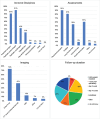The Diagnostics and Management of Bronchopulmonary Sequestration: An International Survey among Specialized Caregivers
- PMID: 38447954
- PMCID: PMC11932755
- DOI: 10.1055/s-0044-1782237
The Diagnostics and Management of Bronchopulmonary Sequestration: An International Survey among Specialized Caregivers
Abstract
Background: Our objective was to explore the treatment preferences for bronchopulmonary sequestration (BPS) among an international group of specialized caregivers.
Methods: Sixty-three participants from 17 countries completed an online survey concerning the diagnostics, treatment, and follow-up. Recruitment took place among members of the Collaborative Neonatal Network for the first European Congenital Pulmonary Airway Malformation Trial Consortium and through the Association for European Pediatric and Congenital Cardiology working group database.
Results: Most of the 63 participants were pediatric surgeons (52%), followed by pediatric pulmonologists (22%), and pediatric cardiologists (19%). The majority (65%) treated more than five cases per year and 52% standardly discussed treatment in a multidisciplinary team. Half of the participants (52%) based the management on the presence of symptoms, versus 32% on the intralobar or extralobar lesion localization. Centers with both surgical and interventional cardiac/radiological facilities (85%) preferred resection to embolization in symptomatic cases (62 vs. 15%). In asymptomatic cases too, resection was preferred over embolization (38 vs. 9%); 32% preferred noninterventional treatment, while 11% varied in preference. These treatment preferences were significantly different between surgeons and nonsurgeons (p < 0.05). Little agreement was observed in the preferred timing of intervention as also for the duration of follow-up.
Conclusions: This survey demonstrates a variation in management strategies of BPS, reflecting different specialist expertise. Most centers treat only a handful of cases per year and follow-up is not standardized. Therefore, management discussion within a multidisciplinary team is recommended. Recording patient data in an international registry for the comparison of management strategies and outcomes could support the development of future guidelines.
Level of evidence: Level IV.
The Author(s). This is an open access article published by Thieme under the terms of the Creative Commons Attribution License, permitting unrestricted use, distribution, and reproduction so long as the original work is properly cited. (https://creativecommons.org/licenses/by/4.0/).
Conflict of interest statement
None declared.
Figures
References
-
- Kane S C, Ancona E, Reidy K L, Palma-Dias R. The utility of the congenital pulmonary airway malformation-volume ratio in the assessment of fetal echogenic lung lesions: a systematic review. Fetal Diagn Ther. 2020;47(03):171–181. - PubMed
-
- Stocker L J, Wellesley D G, Stanton M P, Parasuraman R, Howe D T. The increasing incidence of foetal echogenic congenital lung malformations: an observational study. Prenat Diagn. 2015;35(02):148–153. - PubMed
-
- Adams N C, Victoria T, Oliver E R, Moldenhauer J S, Adzick N S, Colleran G C. Fetal ultrasound and magnetic resonance imaging: a primer on how to interpret prenatal lung lesions. Pediatr Radiol. 2020;50(13):1839–1854. - PubMed
-
- Corbett H J, Humphrey G M. Pulmonary sequestration. Paediatr Respir Rev. 2004;5(01):59–68. - PubMed
MeSH terms
LinkOut - more resources
Full Text Sources
Research Materials







